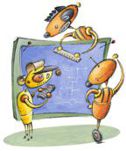Date: November 14, 1996
Speaker: David Tennenhouse, Telemedia, Networks and Systems Group, Laboratory for Computer Science, MIT
Active Networks
Abstract:
Active networks allow individual users, or groups of users, to inject customized programs into the nodes of the network. This approach to network architecture will enable a massive increase in the sophistication and customization of the computation that is performed within the network. In this talk I will discuss the overall motivation for our work, the approach we have adopted, and a prototype implementation that leverages the existing IP options mechanism.
Our work is motivated by both technology push and user pull. The "pull" comes from the ad hoc collection of fire walls, web proxies, multicast routers, mobile proxies, video gateways, etc. - that perform user-driven computation at nodes within the network. We are developing the architectural support and common programming platforms to support the diversity and dynamic deployment requirements of these inter-posed services.
The "push" is the emergence of active technologies, compiled and interpreted, supporting the encapsulation, transfer, inter-position, and safe and efficient execution of program fragments. Today, these technologies are applied above the end-to-end network layer, e.g., to allow clients and servers to exchange fragments. Our innovation is to leverage and extend these technologies for use within the network - in ways that will fundamentally change today's model of what is "in" the network.
Architecturally, we are bumping up the level of abstraction at which inter-operability is achieved: today's routers support the agreed syntax and semantics of IP, e.g., they all perform "equivalent" computations; in contrast, active nodes perform many different computations but must all support an equivalent and inter-operable computational model.
SDI / LCS Seminar Questions?
Karen Lindenfelser, 86716, or visit www.pdl.cmu.edu/SDI/
